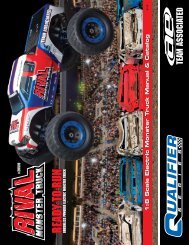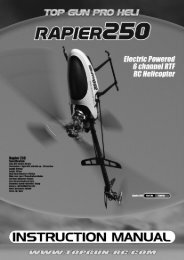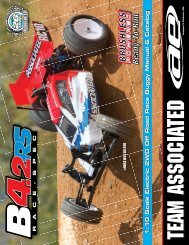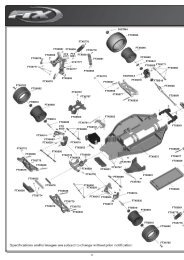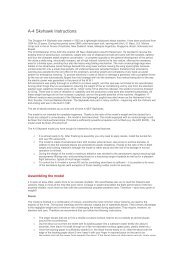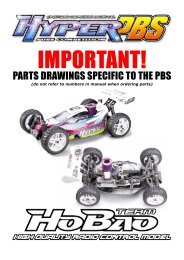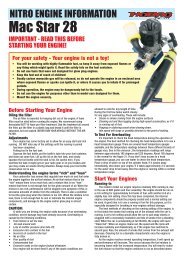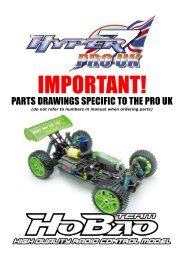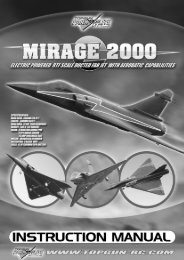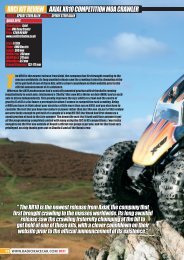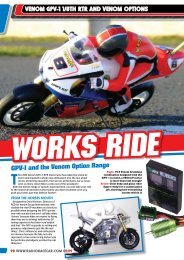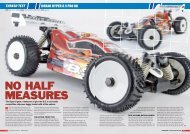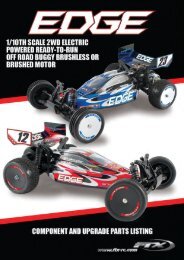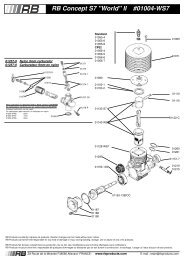Instruction Manual - Team Associated
Instruction Manual - Team Associated
Instruction Manual - Team Associated
Create successful ePaper yourself
Turn your PDF publications into a flip-book with our unique Google optimized e-Paper software.
30<br />
:: Tuning Tips (cont.)<br />
Rear Camber:<br />
A good starting point for the rear camber setting is -1°. In loose track conditions, going to 0° camber can improve<br />
straight-line acceleration.<br />
Rear Hub Spacing:<br />
There are three options for rear hub spacing, FORWARD, MIDDLE, & BACK. The kit setting provides the best possible<br />
rear traction. The FORWARD position will provide more rear traction for low grip tracks. The BACK position will provide<br />
more steering on high grip tracks.<br />
Ride Height:<br />
Ride height is the distance from the ground to the bottom of the chassis. The standard front ride height setting is with<br />
the front arms level (referred to as “arms level”). The standard rear ride height setting is when the outdrive, driveshaft,<br />
and axles all are on the same imaginary horizontal line (referred to as “bones level”). Check the ride height by lifting the<br />
car about 8-12 inches off a table and drop it level. After the suspension “settles” into place, add or remove pre-load clips<br />
on the shock bodies so that the left and right arms appear to be parallel. For precise ride height measurements, use<br />
the Factory <strong>Team</strong> ride height gauge #1449.<br />
Anti-Squat:<br />
Anti-squat denotes the angle of the rear arms relative to the ground. The kit setting is 2 degrees, and can be adjust to<br />
1 degree by removing the included shim above the rear arm mount and replacing it below the rear arm mount.<br />
Changing to less anti-squat tends to make the truck produce more rear traction and less steering in the corners.<br />
Optional Large Fuel Tank:<br />
The SC10GT has a unique radio tray that allows you to install a<br />
larger fuel tank (# 89324) for longer run times. Simply removing<br />
the radio tray insert, and install the optional fuel tank (not included)<br />
over the molded posts on the radio tray with red O-rings (#5407)<br />
for vibration dampening.<br />
6918<br />
89324<br />
6918<br />
5407<br />
5407<br />
Shock Piston and Fluid:<br />
The SC10 GT shocks are built with our 2 hole, #1 pistons in the front shocks, and #3 pistons in the rear shocks.<br />
All pistons have a number molded on it.<br />
As a rule of thumb, larger hole pistons decrease damping which can help the truck in bumpy and low-grip situations.<br />
On smoother tracks, or for large jumps, you may want use a smaller hole piston which will increase damping and take<br />
away some grip. [#1 large hole, #2 medium hole, #3 small hole]<br />
Typically, your SC10 GT shocks will work best with shock fluid rates between 25 and 35 wt (275 - 425 CST).<br />
Use the thicker fluids in the range when changing to larger hole pistons, and also use the thinner weight fluids when<br />
changing to a smaller hole pistons.<br />
Setup Sheets:<br />
Most often, the best way to get your car handling right is to go to our website www.rc10.com and click on the links to<br />
Setup Sheets, then SC10 GT setups. Our team of professional drivers help develop these setups at National events.<br />
Also, most drivers have a “base” setup that they use as a starting point for every event. Try running some of our base<br />
setups OR look for track conditions and tires that are similar to your local track and mimic that setup.<br />
Remember, each adjustment has a purpose, so copy everything from the setup sheet and then make adjustments<br />
based on the recommendations in here and in our online tuning guide.



